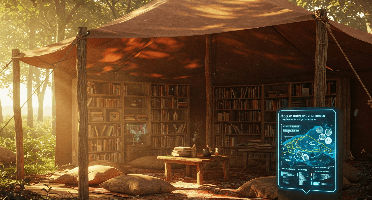
River Roberts
Project OwnerProject Director Library Designer & Build Fund Raising Partnerships Community Engagement

Milestone Release 1 |
$18,000 USD | Pending | TBD |
Milestone Release 2 |
$12,000 USD | Pending | TBD |
Milestone Release 3 |
$12,000 USD | Pending | TBD |
Milestone Release 4 |
$6,888 USD | Pending | TBD |
Inspired by the late great scientist & futurist, James Lovelock, who developed scientific instruments for NASA and that noticed how Earth functions as a self-regulating system. The vision for Project Lovelock is to create a global network of AI enhanced physical Library spaces that make it easy, insightful and inspiring to understand Earth’s ever evolving self-regulating systems on a bio-regional scale and how to better live in harmony with them. This environmentally integrated network empowers landowners, local councils and communities with crucial information for improved long term decision-making.
To verify bio-regional bio diversity of insects and birds.
NLP interface with the bio-regional data sets
Integrating Satellite Data with pre-existing weather data sets and local sensor input to provide recommendations.
Project Lovelock stands out with its fresh approach to biodiversity conservation. Particularly impressive is how it addresses real-world challenges like agricultural land finance while promoting ecological awareness. It aligns well with the BGI vision: responsible AI use that empowers communities to become better stewards of their environments. There are some questions about scalability, as it offers local solutions; implementations need customizing for different bioregions, and maintaining user engagement. However, this project has genuine potential to transform how communities interact with their local environments. It's a smart concept that could make a real difference if executed well.
New reviews and ratings are disabled for Awarded Projects
Deploy 50 IoT sensors & aggregate pre-existing data sources
Deploy up to 50 sensors (weather stations water sensor soil sensor audio sensor). Aggregate pre existing satellite geological weather and historic data from local councils and private owners.
$18,000 USD
The most comprehensive bio-regional data set
Bio-regional Agent interface based on pre-existing data
LM/Agent to interface with bio-regional data set. UI on android tablet.
$12,000 USD
Most user friendly interface for most comprehensive bio-regional data set
Preparation of the Mobile Library Unit & Opening to Public Community engagement sessions
Design & Build Physical Library Space Open Library to the public Host 8 workshops and mastermind circles to better understand local context challenges and priorities.
$12,000 USD
500 visitors to the library Engagement by local stakeholders to share knowledge and data 200 Queries to AI Model
Development of the model to integrate and interpret live sensor data and community insights from workshops and mastermind circles
Improved bio-regional AI insights from local qualitative and quantitative inputs
$6,888 USD
Local stakeholders seeking advice from the library on decisions for their land Measurably improved insights from pre-existing data sets
Please create account or login to post comments.
Reviews & Ratings
Project Lovelock stands out with its fresh approach to biodiversity conservation. Particularly impressive is how it addresses real-world challenges like agricultural land finance while promoting ecological awareness. It aligns well with the BGI vision: responsible AI use that empowers communities to become better stewards of their environments. There are some questions about scalability, as it offers local solutions; implementations need customizing for different bioregions, and maintaining user engagement. However, this project has genuine potential to transform how communities interact with their local environments. It's a smart concept that could make a real difference if executed well.
New reviews and ratings are disabled for Awarded Projects
© 2025 Deep Funding

Sort by